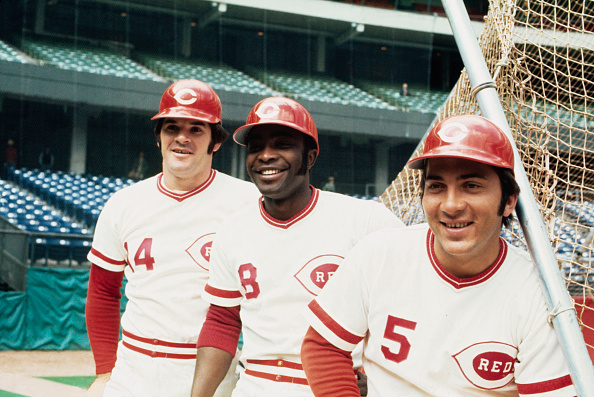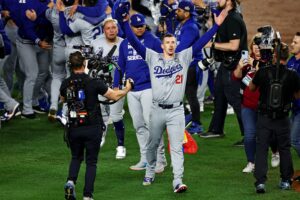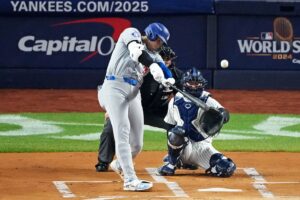The Cincinnati Reds‘ all-time team is straightforward to pick. But, one of the biggest challenges was figuring out which position to place baseball’s all-time leading hitter. That particular player played more than 600 games as a Red all over the baseball field. Nevertheless, quite a few players were locks at certain positions. Most of the team is made up from the iconic “Big Red Machine” era with some surprises. As we continue our all-time tournament team, the Reds’ all-time team is here.
Reds All-Time Team
Batters
Catcher- Johnny Bench (1967-1983)
2,048 H, 1,091 R, 389 HR, 1,376 RBI, 68 SB, .267/.342/.476, 126 OPS+, 75.1 WAR
There is no debate with this one. Johnny Bench is the best Reds catcher in franchise history and possibly the best backstop. He has the second-highest WAR in franchise history. After a 17-year career, Bench was the NL Rookie of the Year in 1967 and won the NL MVP in 1970 and 1972. He’s a two-time World Series champion who slugged 389 home runs, the third most for the position.
First Base- Joey Votto (2007-Present)
2,027 H, 1,114 R, 331 HR, 1,065 RBI, 80 SB, .302/.416/.520, 148 OPS+, 64.6 WAR
When his career is over, Joey Votto will go down as one of the best Reds. His MVP season in 2010 saw him hit 37 home runs with a .324 batting average and a league-leading 1.024 OPS. The Canadian nearly won a second MVP in 2017 with almost identical numbers. His 331 home runs are second all-time for the Reds. He’s third with 435 doubles, fourth with 1,114 runs, and sixth in hits. Votto owns the Reds’ record with a .416 OBP. His resume will be very worthy of consideration for the Hall of Fame.
Second Base- Joe Morgan (1972-1979)
1,155 H, 816 R, 152 HR, 612 RBI, 406 SB, .288/.415/.470, 147 OPS+, 57.9 WAR
Once Joe Morgan was acquired from the Houston Astros in 1972, it gave the Reds the missing piece to their dynasty. Morgan is the Reds’ all-time leader with 406 steals.
Third Base- Pete Rose (1963-1978, 1984-1986)
3,350 H, 1,741 R, 152 HR, 1,036 RBI, 146 SB, .307/.379/.425, 124 OPS+, 78.1 WAR
Pete Rose played only 18 percent of his games at third base. However, playing the hot corner proved to be a success since Rose mostly played there from 1975-78. That was when the Big Red Machine won back-to-back World Series titles. He is one of the best Reds ever, and in the game in general. Furthermore, he’s the franchise’s all-time leader in runs, hits, singles, doubles, and walks. Rose is baseball’s all-time leader with 4,256 hits, accumulating 3,350 of those with Cincinnati. He also won the 1963 NL Rookie of the Year Award, the 1973 NL MVP, and World Series MVP in 1975.
Shortstop- Barry Larkin (1986-2004)
2,340 H, 1,329 R, 198 HR, 960 RBI, 379 SB, .295/.371/.444, 116 OPS, 70.5 WAR
Barry Larkin played all of his 19 seasons with his hometown Reds. The Cincinnati native was a 12-time All-Star, World Series champion, the 1995 NL MVP, and the three Gold Gloves and nine Silver Slugger Awards. He batted .319 with a .886 OPS during his MVP season, leading the Reds to the NLCS. Next season, he hit a career-high 33 home runs with 46 steals. He became the first shortstop and second Red to have a 30/30 season.
Left Field- George Foster (1971-1981)
1,276 H, 680 R, 244 HR, 861 RBI, 46 SB, /286/.356/.514. 140 OPS+, 39.5 WAR
The Reds acquired George Foster from the San Francisco Giants in 1971. Foster was a part-time player until Rose was moved from left field to third base in 1975. That paved the way for Foster, who slashed .300/.356/.518 with 23 home runs. Also, he batted .364 in NLCS while adding a pair of RBIs in the Reds World Series victory. The following season, Foster batted .306/.364/.530 with a league-leading 112 RBIs. However, his best season came in 1977, winning the NL MVP Award while setting club records with 52 home runs and 149 RBIs.
Center Field- Vada Pinson (1958-1968)
1,881 H, 978 R, 186 HR, 814 RBI, 221 SB, .297/.341/.469, 119 OPS+, 47.7 WAR
Vada Pinson’s 47.7 WAR is eighth all-time for Cincinnati. In his 11 seasons with the Reds, Pinson batted .297/.341/.469 with 186 home runs. Some of his best seasons came before he was 25. He led the NL in runs, hits, doubles, and triples at different points in his career. When the Reds won the NL pennant in 1961, he was third in MVP voting but won a Gold Glove Award. In franchise history, Pinson is seventh all-time in hits, sixth in doubles, and 13th in home runs.
Right Field- Frank Robinson (1956-1965)
1,673 H, 1,043 R, 324 HR, 1,009 RBI, 161 SB, .303/.389/.554, 150 OPS+, 63.8 WAR
Frank Robinson quickly established himself as a feared hitter. As a 20-year-old, he hit 38 home runs and scored a league-leading 122 runs, winning the NL Rookie of the Year Award. Then, he would hit 30 or more home runs in five of the next six seasons. In 1961, Robinson hit .323 with 37 home runs and 124 RBI while leading the Reds to the first pennant in 21 years. The following season, he did one better, hitting .342 with 39 home runs, 136 RBI with an MLB-leading 134 runs scored.
Designated Hitter- Tony Pérez (1964-1976, 1984-1986)
Often considered the glue of the Big Red Machine, Tony Perez played in four World Series for the Reds. His two-run home run in Game 7 of the 1975 World Series was one of three he hit in that series. Of the 379 homers, the Cuban slugger hit 287 of them with the Reds. He ranks sixth on the club’s all-time list with 1,948 games, seventh with 1,934 hits, and second with 1,192 RBI.
Manager- Sparky Anderson (1970-1978)
863-586, four pennants, two World Series titles
Sparky Anderson had the skulls in the dugout and clubhouse to help Cincinnati become the Big Red Machine. Anderson is the club’s all-time leader in managerial wins with 863. Furthermore, he led the club to four NL pennants and two World Series titles. The Reds only experienced one losing season under Anderson’s nine-year tenure. The Reds dismissed Anderson following the 1978 season. However, he would manage the Detroit Tigers from 1979-to-1995.
Pitchers
Starter- Eppa Rixey (1921-1933)
179-148, 3.33 ERA, 2890 2/3 IP, 660 SO, 118 ERA+, 1.28 WHIP, 40.9 WAR
A trade to the Reds in 1920 revived Eppa Rixey’s career. Not only did Cincinnati get a future Hall of Famer, but Rixey put together an eight-year stretch where he averaged 18 wins, and 270 innings pitched. In 1921, Rixey allowed just one home run in the 301 innings he pitched. He led the league with 25 wins and 313 1/3 innings pitched. At 41-years-old, Rixey threw 27 consecutive scoreless innings from July 24 to August 28. Altogether, Rixey is the Reds’ all-time leader in wins, innings pitched, and starts.
Relievers- Aroldis Chapman, Rob Dibble, Danny Graves
Aroldis Chapman defected from Cuba as the Reds signed him to a six-year, $30 million contract. Chapman was able to develop his fastballs at speeds over 100mph. He would then become the Reds closer in 2012, who went to four consecutive All-Star Games. Chapman played for three Reds teams who went to the playoffs. In addition, he is third among relievers with 546 strikeouts, and his 15.4 strikeouts-per-nine-innings ratio is the best in Red’s history. Altogether, his 146 saves are fourth on the club all-time.
Rob Dibble was one of “The Nasty Boys” trio of Reds relievers in the 1990 World Series-winning team. In that season, Dibble went 8-3 with a 1.74 ERA and 136 strikeouts. Over six seasons with Cincinnati, the right-hander recorded 88 saves with a 2.74 ERA.
Danny Graves is the franchise’s all-time leader with 182 saves. From 1998 to 2002, the right-hander posted a 3.23 ERA. Furthermore, he was named the team closer in 1999, and 2000, he was named an All-Star. An unfortunate decision landed Graves in the starting rotation in 2003, only to return to the bullpen the following season. He recorded a career-high 41 saves there while earning his second All-Star nod.
Honorable Mentions
Dave Concepción, Paul Derringer, Ken Griffey, Gus Bell
Before Larkin was the shortstop, it was Dave Concepción for 18 years. Concepción was the defensive master of the Reds teams that won five division titles and consecutive World Series titles. He was a nine-time All-Star and won five Gold Gloves, second behind Bench’s 10. On the other hand, he is third on the club all-time in hits, doubles, and steals. He was also the team captain, and his No.13 was retired in 2007.
Players/Managers Mentioned:
Johnny Bench, Joe Morgan, Pete Rose, Barry Larkin, George Foster, Vada Pinson, Frank Robinson, Sparky Anderson, Eppa Rixey, Aroldis Chapman, Rob Dibble, Danny Graves, Dave Concepción, Paul Derringer, Ken Griffey, Gus Bell






